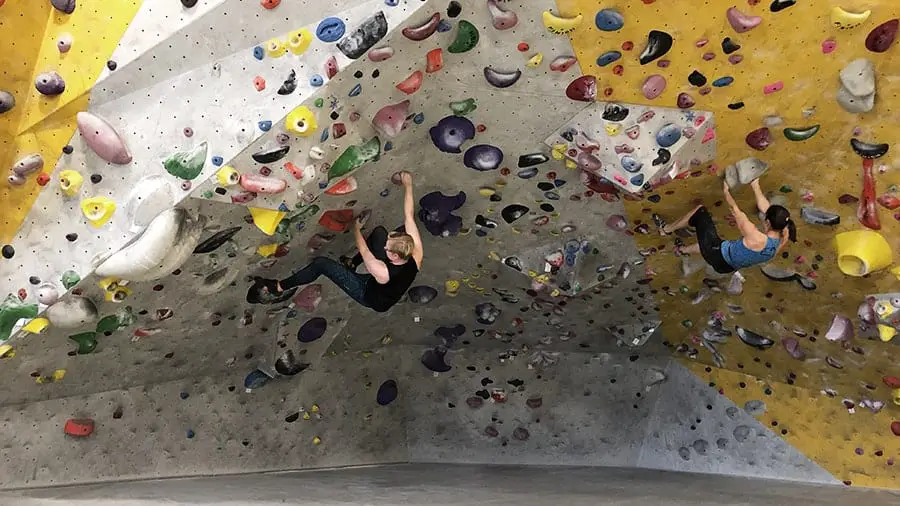I’ve been at the bouldering gym a lot lately and a few of my friends were wondering if bouldering is dangerous. To help settle their concerns (and my own), I decided to do some research to find out.
Is bouldering dangerous? There are more injuries from bouldering than there are from rope climbing but that doesn’t mean it is dangerous. When using caution and good technique, indoor bouldering can be an enjoyable and safe activity.
A nice thing about bouldering is that it’s easier to get into than rope climbing because you only need shoes and chalk.
However, the low barrier to get into bouldering also makes it more likely to see people get injured because they haven’t been properly trained. Below is what I learned about common climbing injuries, what causes injuries and how to be safer when bouldering.
Common Injuries in Bouldering?
One of the most enjoyable aspects of bouldering is how simple it is. You don’t have to bring rope or carabiners, all you need are shoes and chalk.
The lack of gear also means that when you fall, you will hit the ground 100 percent of the time.
In a study that surveyed climbers, they found that hand injuries were the most common injury reported, however, another study that looked at rock climbing injuries treated in emergency departments in the U.S. shows that fractures, sprains, and strains accounted for the largest portion of injuries.
From what I’ve observed, hand and elbow tendon injuries are the most common and it is likely that climbers with those injuries don’t report to the emergency departments for treatment, which is probably why the two studies noted above show different results.
Here are some common injuries in bouldering:
- Pulled Tendons in your fingers and hands – a common hold in bouldering is called a crimp, which is where the most finger and hand injuries are caused because it is one of the easiest holds to put too much pressure on the hand tendons
- Sprained ankles from falling on your feet wrong – though the padding mitigates the impact of falling on your feet, the surface you are landing on, you can still land on your feet wrong causing a sprain
- Sprained wrists from falling on your hands – this seems to happen the most when climbing on overhangs and the feet slip causing your body to fall forward and landing on your wrists
- Climber’s elbow, also commonly called tennis elbow is caused by straining the tendons near your elbow too much
- Climber’s Knee is similar to climber’s elbow except it is in your knee from twisting and contouring the knee causing strain on the tendons
Each of these injuries can interrupt your daily life at work or play so make sure that you are paying attention to what your body is telling you and stop if you feel signs of an injury.

Common Causes Of Injuries
A common concern that people have about bouldering is the size of the mats below you when you fall. Luckily, indoor bouldering gyms usually have really thick mats that cover a large area so you don’t have to worry about thin mats as much. However, there are a few other things that commonly contribute to injury.
Doing climbs way above your skill level:
I’ve seen many people, who haven’t climbed before, attempt difficult climbs using sheer strength and no technique. The problem with this is that they are more likely to get injured by forcing their bodies to do something it isn’t supposed to do instead of using proper technique. In addition, you are more likely to fall if you are climbing way above your skill level and every time you fall, you are at risk of injury.
Overuse of tendons:
As mentioned above, tendon injuries are probably the most common injury and it is commonly caused by overusing them. Your tendons take more time to build stamina than your muscles and climbers frequently forget that. As their muscles get stronger, they are more likely to keep progressing the difficulty of climbs without regard to the increasing need for tendon strength. One way to prevent this is to listen to your body. If you have pain in your hand or elbow, stop. One or two more climbs aren’t worth long-term injury.
Also, if you are thinking about training on a hang board, wait till you have been climbing for a couple of years so that you have built adequate tendon stamina and then research the best training methods so you don’t overuse your tendons while training on a hang board.
Walking under a climber:
One of the number one rules at indoor bouldering gyms is no walking under climbers. The most obvious reason for this is because they might fall on you. What could have been a safe fall for them turns into injuries for both the person falling and the person they land on. Be smart and pay attention to where you are walking.
Twisting your knees:
A common move in indoor bouldering is called a drop-knee, where the position of your knee twists to move your hip closer to the wall. If you do not twist your foot position to compensate for the knee movement, you are more likely to get injured because it twists the tendons in your knee in a way that it’s not built to support.
How To Decrease Danger While Indoor Bouldering
There is no gymnastics fall in bouldering because every fall is different so even a well-seasoned climber can get injured, but there are some ways to boulder safely.
- Don’t jump down from a climb. If you can control how close you are from the ground when dismounting from the wall, then get as close to the ground as possible. This will help prevent injuries caused by hitting the ground
- Use proper techniques when contorting your body to do different moves. There are a few ways you can learn technique – getting a coach is probably the easiest way to learn technique, but it isn’t always affordable. Instead, you can check out blogs like this, review videos on YouTube, watch climbing competitions on TV, or even ask a fellow climber for recommendations
- Get a spotter if you feel like you need one. Though spotting is less common in indoor bouldering because of the array in deep mats, this may still be helpful if a climber is outside of matt cover. Be cautious of who is spotting you though, you don’t want to cause an injury by having an inexperienced spotter stand below you when you fall.
- Try landing on your feet with your knees bent. This won’t guarantee safety from injury when landing, but bending your knees will help disperse the impact force throughout your body. This isn’t gymnastics so you don’t have to stick the landing. When you land, allow your body to roll onto your side, back, or shoulder. *Keep your head tucked to prevent whiplash.*
- Avoid catching yourself with your hands. I have found that when I am climbing an overhang, my falls are commonly caused by losing my footing and the momentum of my legs swinging makes me lose my grip, resulting in falling face first. When this happens, I try to catch myself on my knees and engage my core to prevent injury. I also try not to catch myself with my hands to prevent wrist sprains.
- Climbing.com had a really good suggestion: Remove all jewelry, belts, and anything heavy or sharp in your pockets or on your person that could cause injury to you or others, including keys, phone, and wallet. A ring getting caught on the rock or you landing on your keys can be extremely painful, so just put it away.
Conclusion
Indoor bouldering is a fun activity and a great way of getting into climbing but it can be dangerous. However, there are plenty of ways to avoid injury and boulder safely – it probably isn’t more dangerous than any other sport such as basketball, soccer, football or gymnastics.
In fact, the safety gear and techniques in climbing likely make it easier to avoid injury than it is to avoid injury in other sports such as the ones listed above.
If you have recommendations for making indoor bouldering safer or a horror story that you want to share, please leave a comment. We would all love to hear what you think.
More Trending Topics Like This:
- What Happened During The Men’s 2021 Climbing Olympics?
- Who Are The Climbers Competing In The Tokyo Olympics 2021?
- Is Climbing A Sport?
- How Many Calories Do You Burn From Climbing?
- 17 Reasons Why Bouldering Is So Popular
- The Evolution Of Climbing Belay Devices
- 23 Storage Ideas For Your Climbing Gear
- Why Is Climbing Such A Mental Sport?
- The Best Way To Take Climbing Chalk Through Airport Security
- Is Bouldering That Hard? Yea, It’s Hard – This Is Why
- Is Climbing Considered A Sport
- Is Climbing And Bouldering Good For Cardio?
- Top 10 Home Climbing Gym Designs
- 9 Signs You’re Seriously Addicted To Climbing
- Why Do People Like Climbing?
- What You Need To Know About Climbing In The 2021 Tokyo Olympics
- Can Climbing Build Abs And Make You Look Chiseled
- How To Introduce Your Friends To Climbing (15 Steps)
- Tips For Handling Your Period While Climbing
- Is Bouldering Outdoors Harder Than Indoors?
- Can You Go Rock Climbing Outdoors During The Covid 19 Pandemic?
- 7 Reasons To Wear Socks With Climbing Shoes
- What Is Dabbing? | Climbing Vocabulary And Culture
- Bouldering Vs Climbing: Training, Skills, Strength, Grades
- Indoor Vs Outdoor Climbing: A Thorough Comparision
- 22 Health Benefits Of Climbing – Backed By Research
- Bouldering And Sports Climbing Glossary: Lingo And Language
- Quick Tips For Getting Back Into Climbing After A Long Break
- 10 Legit Reasons You Should Not Rock Climb
- Can Climbing Build Muscle And Replace Weight Training?
- Do You Wear Socks With Rock Climbing Shoes?
- Is Bouldering Dangerous?
- What Should You Record In A Climbing Journal?
- How Are Climbing Routes Graded?
- First Time At The Bouldering Gym – What You Should Know
- 7 Common Mistakes In Rock Climbing For Beginners
- How Do Alpinists Get Down?

